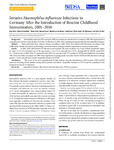2020-09-18Zeitschriftenartikel
Invasive haemophilus influenzae infections in Germany after the introduction of routine childhood immunization, 2001–2016
Takla, Anja
Schönfeld, Viktoria
Claus, Heike
Krone, Manuel
an der Heiden, Matthias
Koch, Judith
Vogel, Ulrich
Wichmann, Ole
Lâm, Thiên-Trí
Background. Haemophilus influenzae (Hi) serotype b (Hib) vaccination was introduced in Germany in 1990. This study presents a
comprehensive overview on the burden of invasive Hi infections for 2001–2016, including serotype distribution and ampicillin resistance.
Methods. Nationwide data from statutory disease surveillance (2001–2016) were linked with laboratory surveillance data
(2009–2016). Besides descriptive epidemiology, statistical analyses included multiple imputation to estimate secular trends.
Results. In 2001–2016, 4044 invasive Hi infections were reported. The mean incidence was 3.0 per million inhabitants, higher
in males (3.2 vs 2.9 in females) and in the age groups <1 year (15.2) and ≥80 years (15.5). Nontypeable Hi (NTHi) caused 81%
(n = 1545) of cases in 2009–2016. Of capsulated cases, 69% were serotype f and 17% serotype b. Of Hib cases eligible for vaccination,
10% (3/29) were fully vaccinated. For 2009–2016, significant increasing trends were observed for NTHi and Hif infections in the age
groups <5 years and ≥60 years and for ampicillin resistance in NTHi.
Conclusions. This is one of the most comprehensive Hi data analyses since the introduction of Hib vaccines. NTHi and Hif
cause an increasing disease burden among elderly patients and infants. Ampicillin resistance in NTHi must be considered in the
treatment of invasive Hi infections.
Dateien zu dieser Publikation

